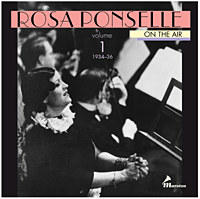
|
Rosa Ponselle On the Air, Volume 1Rosa Ponselle was arguably this century's greatest soprano. Artists such as Callas and Caruso acknowledged her vocal supremacy. Ponselle's voice had volume, beauty, emotion, sure intonation and remarkable flexibility. Before Rosa Ponselle (1897-1981), there had been no leading American singer who had not first made his or her mark abroad. This two CD-set marks the first volume of her on the air recordings. By Ponselle's own account, her broadcasts captured her true voice and she preferred these performances to her numerous commercial recordings. This set chronicles the Chesterfield broadcasts from 1934-1936 which demonstrate Ponselle at her best. |
|
|

Today, anyone who owns a cassette or VCR recorder has probably taped programs off of radio or television. It has become as simple as inserting a tape into the machine and pressing a button. Prior to the advent of magnetic tape, however, recording off the air was not such an easy matter.
By the mid-1920s, radio and recordings had become competitive forms of home entertainment, and all but the poorest households could boast of owning a radio and a record player. The development of the electrical recording process made it feasible to record radio broadcasts, but this could only be accomplished by cutting a wax master and having it plated and pressed, in exactly the way that commercial recordings were produced. There was, as yet, no method for making recordings that could be immediately played back. During this period, the major record companies occasionally made recordings of broadcasts of important events, yet few of these were actually issued to the public. There were also instances of individuals or corporations hiring record companies to make custom recordings of particular broadcasts. Because of the expense involved in such an undertaking, occurrences of this sort were very few.
During the early 1930s, two methods for making instantaneous playback disc recordings were developed. The first utilized pre-grooved discs and a special cutting head that attached to an ordinary record player. This method produced very poor results and was meant only for home-use. Radio stations began to make instantaneous recordings of their broadcasts using a more sophisticated process of cutting grooves into an aluminum disc; though sonically inferior to commercial recordings, these disks were remarkable for their time. This type of disc was replaced in 1935 by an improved aluminum disc coated with acetate, which was capable of capturing much higher frequencies. By this time musical artists were beginning to request that their broadcasts be recorded, but many of these recordings were either completely ruined by repeated playing with blunt needles, or discarded when their novelty had worn off. Therefore, few broadcasts from this early period exist in listenable sound.
The recordings contained in this two CD set were transferred directly from original aluminum and acetate discs, some of which are in pristine condition, others are not. These recordings were made using two turntables, and the breaks between sides were not always made at logical points. I have tried to make smooth side joins, but this has often been impossible due to the change in character of the surface noise from the end of one side to the beginning of the next. When listening to these discs, one must keep in mind these broadcasts were not intended for a “high brow” audience and the selections chosen for Miss Ponselle to sing mirror that concept. Also, I have included all existing introductory announcements in order to convey the atmosphere of the original broadcast.
I intend later this year to issue a second volume of Rosa Ponselle radio appearances which will comprise two remaining Chesterfield programs and all extant non-Chesterfield broadcasts.
Please stay tuned.